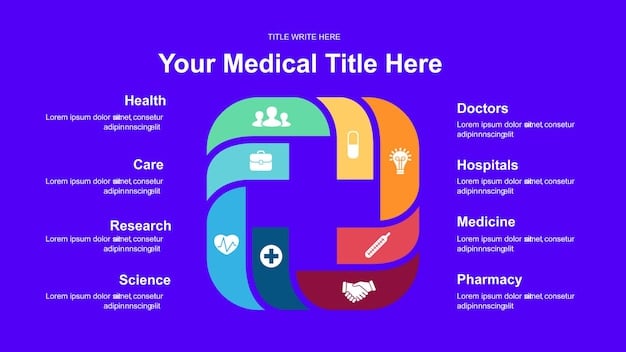The Future of Medicare: Proposed Changes & Healthcare Impact

The Future of Medicare: Understanding the Proposed Changes and Their Impact on Your Healthcare involves analyzing potential modifications to the program, including eligibility, coverage, and financing, and assessing how these changes may affect access to care, costs, and the overall health and well-being of beneficiaries.
Navigating the complexities of healthcare can be daunting, especially when it comes to understanding government programs like Medicare. As we look toward the future of Medicare: Understanding the Proposed Changes and Their Impact on Your Healthcare, it’s crucial to stay informed about potential shifts that could affect your coverage, costs, and access to vital medical services.
Understanding the Current Medicare Landscape
Before diving into the future, it’s essential to understand the current state of Medicare. This will provide a solid foundation for evaluating proposed changes and their potential impact on you and millions of other Americans.
Medicare, established in 1965, is a federal health insurance program primarily for people 65 or older, regardless of income, health status, or employment history. It also covers younger people with disabilities and those with End-Stage Renal Disease (ESRD) or Amyotrophic Lateral Sclerosis (ALS).
The Core Components of Medicare
Medicare is divided into four parts, each covering different aspects of healthcare:
- Part A (Hospital Insurance): Covers inpatient hospital stays, skilled nursing facility care, hospice care, and some home health care.
- Part B (Medical Insurance): Covers doctor’s visits, outpatient care, preventive services, and some medical equipment.
- Part C (Medicare Advantage): Private health insurance plans that contract with Medicare to provide Part A and Part B benefits, often including Part D (prescription drug) coverage.
- Part D (Prescription Drug Insurance): Covers prescription drugs through private plans that contract with Medicare.
Understanding these parts is crucial for appreciating the potential impact of any proposed changes to the program. Each part has its own funding mechanisms, coverage rules, and cost-sharing requirements.

The current Medicare system is financed through a combination of payroll taxes, premiums paid by beneficiaries, and general revenue from the federal government. As healthcare costs continue to rise and the population ages, the financial sustainability of Medicare is a growing concern, making reform proposals increasingly relevant.
Key Challenges Facing Medicare
Medicare faces several significant challenges that necessitate ongoing discussions about its future. Addressing these challenges is crucial to ensure that the program can continue to provide affordable and quality healthcare to its beneficiaries.
One of the most pressing challenges is the rising cost of healthcare. Advancements in medical technology, increasing prescription drug prices, and a growing demand for services are all contributing to escalating costs. This puts a strain on the program’s finances and could lead to higher premiums and cost-sharing for beneficiaries.
Demographic Shifts and Increased Enrollment
The aging of the U.S. population is another major challenge. As the baby boomer generation enters retirement, the number of Medicare beneficiaries is growing rapidly. This increased enrollment puts additional pressure on the program’s resources and requires ongoing adjustments to ensure its sustainability.
- Aging Population: The number of Americans aged 65 and older is projected to increase significantly in the coming decades, leading to higher Medicare enrollment.
- Increased Demand for Services: As people age, they tend to require more healthcare services, which further drives up costs.
- Workforce Shortages: A shortage of healthcare professionals could limit access to timely and quality care for Medicare beneficiaries.
Payment Models and Quality of Care
Another critical area of focus is the need to improve the quality of care and address disparities in healthcare access and outcomes. Traditional fee-for-service payment models often incentivize volume over value, leading to fragmented care and potentially unnecessary tests and procedures.
Innovative payment models, such as accountable care organizations (ACOs) and bundled payments, aim to promote better care coordination and reward providers for delivering high-quality, cost-effective care. These models are being tested and refined to determine their effectiveness in improving the Medicare system.
These challenges highlight the importance of exploring potential changes to Medicare, including strategies to control costs, improve care delivery, and ensure the program remains financially sustainable for future generations.
Exploring Proposed Changes to Medicare
Numerous proposals have been put forth to address the challenges facing Medicare. These proposals range from incremental adjustments to more comprehensive reforms, each with its own potential impact on beneficiaries and the healthcare system as a whole.
Some proposals focus on controlling costs by negotiating drug prices, reducing payments to providers, or increasing cost-sharing for beneficiaries. Others aim to improve care delivery by promoting preventive services, expanding access to telehealth, or strengthening care coordination.
Premium Support and Voucher Programs
One controversial proposal involves transitioning Medicare to a premium support or voucher program. Under this model, beneficiaries would receive a fixed amount of money to purchase a health insurance plan of their choice, either from traditional Medicare or a private insurer.
- Increased Choice: Proponents argue that premium support would give beneficiaries more control over their healthcare choices and encourage competition among insurers.
- Potential Cost Savings: Some believe that competition would drive down costs and improve efficiency in the healthcare system.
- Risk of Underfunding: Critics worry that the fixed subsidy may not keep pace with rising healthcare costs, leaving beneficiaries with higher out-of-pocket expenses.
Raising the Eligibility Age
Another frequently discussed proposal is raising the eligibility age for Medicare from 65 to 67. Supporters argue that this would align Medicare’s eligibility age with the Social Security retirement age and help to reduce the program’s costs.
However, opponents raise concerns about the potential impact on older Americans who may not be able to afford private health insurance or who have pre-existing conditions that make it difficult to obtain coverage. Raising the eligibility age could also shift costs to employers and state governments.

It’s important to note that many of these proposals face significant political hurdles and there is no guarantee that any particular reform will be enacted. However, understanding the potential changes and their likely effects is essential for engaging in informed discussions about the future of Medicare.
The Impact on Access to Healthcare
One of the most significant concerns surrounding proposed changes to Medicare is their potential impact on access to healthcare for beneficiaries. Changes to coverage, cost-sharing, or provider payments could all affect the ability of people to receive timely and appropriate medical care.
For example, proposals to increase cost-sharing, such as deductibles, co-pays, or coinsurance, could make it more difficult for low-income beneficiaries to afford necessary healthcare services. This could lead to delayed or forgone care, potentially resulting in poorer health outcomes and higher overall costs in the long run.
Geographic Disparities in Access
Geographic disparities in access to healthcare are also a major concern. Rural areas often have fewer healthcare providers and limited access to specialized services. Changes to Medicare payment policies could exacerbate these disparities, making it even harder for people in rural communities to receive the care they need.
Telehealth has the potential to improve access to care in underserved areas, but it’s important to ensure that Medicare beneficiaries have access to the necessary technology and support to utilize these services effectively. Broadband access and digital literacy are crucial for realizing the full potential of telehealth.
- Increased Cost-Sharing: Higher deductibles and co-pays could deter low-income beneficiaries from seeking necessary care.
- Reduced Provider Payments: Lower payments to hospitals and physicians could lead to fewer providers participating in Medicare.
- Rural Healthcare Access: Rural areas may be disproportionately affected by changes to Medicare payment policies.
Protecting Vulnerable Populations
It’s important to carefully consider the potential impact of proposed changes on vulnerable populations, such as people with disabilities, chronic illnesses, or low incomes. These groups may be particularly reliant on Medicare for their healthcare coverage and may be more sensitive to changes in costs or coverage.
Policymakers should carefully evaluate the potential consequences of any proposed changes to Medicare and take steps to mitigate any adverse effects on access to care. This could include targeted subsidies or other measures to protect vulnerable populations.
Ultimately, ensuring that all Medicare beneficiaries have access to affordable and quality healthcare should be a guiding principle in any reform effort. Balancing cost control with access to care is a critical challenge that requires careful consideration and thoughtful policymaking.
The Role of Technology in Medicare’s Future
Technology is playing an increasingly important role in healthcare, and Medicare is no exception. From telehealth to electronic health records to artificial intelligence, technology has the potential to transform the way healthcare is delivered and improve outcomes for beneficiaries.
Telehealth, in particular, has emerged as a promising tool for expanding access to care, especially in rural or underserved areas. Telehealth allows beneficiaries to consult with doctors, receive diagnoses, and manage chronic conditions remotely, using video conferencing, mobile apps, and other technologies.
Electronic Health Records and Data Analytics
Electronic health records (EHRs) have become increasingly widespread in recent years, and they offer the potential to improve care coordination, reduce medical errors, and promote better communication between providers and patients. EHRs can also be used to track population health trends and identify opportunities for targeted interventions.
- Telehealth Expansion: Remote consultations can improve access to care, particularly in rural areas.
- Data-Driven Insights: EHRs can facilitate better care coordination and population health management.
- Artificial Intelligence: AI can assist in diagnosing illnesses and personalizing treatment plans.
Addressing Data Privacy and Security
Artificial intelligence (AI) is another area of growing interest in healthcare. AI algorithms can be used to analyze medical images, diagnose diseases, and personalize treatment plans. AI has the potential to improve the accuracy and efficiency of healthcare delivery, but it also raises important ethical and privacy concerns.
Ensuring the privacy and security of patient data is crucial as technology plays a larger role in healthcare. Robust security measures and clear data governance policies are needed to protect against unauthorized access and misuse of sensitive information. Transparency and patient control over their data are also essential.
Harnessing the power of technology while safeguarding patient privacy and security is a key challenge for the future of Medicare. By embracing innovation and implementing appropriate safeguards, Medicare can leverage technology to improve the quality, efficiency, and accessibility of healthcare for its beneficiaries.
Empowering Beneficiaries Through Education
In order to effectively navigate the complexities of Medicare and make informed decisions about their healthcare, beneficiaries need access to clear, accurate, and timely information. Empowering beneficiaries through education is essential for ensuring that they can take full advantage of the benefits offered by Medicare.
Medicare offers a variety of resources to help beneficiaries understand their coverage options, rights, and responsibilities. These resources include the Medicare.gov website, the “Medicare & You” handbook, and personalized assistance from trained counselors at State Health Insurance Assistance Programs (SHIPs).
Improving Health Literacy and Engagement
However, many beneficiaries still struggle to understand the nuances of Medicare and may not be aware of all the resources available to them. Improving health literacy and promoting greater beneficiary engagement are key priorities for the future.
- Clear Communication: Information should be easy to understand and accessible to people with diverse backgrounds and levels of health literacy.
- Personalized Assistance: Trained counselors can provide one-on-one support to help beneficiaries navigate their options.
- Community Outreach: Educational programs can be offered in community settings to reach people who may not be aware of available resources.
The Importance of Informed Decision-Making
Providing beneficiaries with the tools they need to make informed decisions about their healthcare is not only beneficial for them individually, but also contributes to a more efficient and sustainable healthcare system as a whole. When beneficiaries are empowered to make informed choices, they are more likely to seek appropriate care, manage their health effectively, and avoid unnecessary costs.
Investing in beneficiary education and outreach is a critical component of ensuring the long-term success of Medicare. By empowering beneficiaries with the knowledge and support they need, we can help them to live healthier, more fulfilling lives.
Ultimately, the future of Medicare depends on a collaborative effort involving policymakers, healthcare providers, and beneficiaries themselves. By working together to address the challenges and embrace the opportunities that lie ahead, we can ensure that Medicare continues to provide affordable and quality healthcare for generations to come.
| Key Point | Brief Description |
|---|---|
| 💡 Proposed Changes | Explore potential reforms like premium support and raising eligibility age. |
| 🏥 Healthcare Access | Understand how changes impact access, especially for vulnerable groups. |
| 🚀 Technology’s Role | Discover telehealth, EHRs, and AI’s impact on Medicare’s efficiency. |
| 📚 Beneficiary Education | Learn about resources to help navigate Medicare complexities. |
Frequently Asked Questions (FAQ)
▼
Medicare is a federal health insurance program primarily for people 65 or older and certain younger people with disabilities or chronic diseases. Eligibility generally requires U.S. citizenship or legal residency and a work history that qualifies for Social Security benefits.
▼
Medicare consists of Part A (hospital insurance), Part B (medical insurance), Part C (Medicare Advantage), and Part D (prescription drug insurance). Each part covers different aspects of healthcare services and has varying costs and coverage rules.
▼
Proposed changes could affect coverage through adjustments to premiums, deductibles, covered services, or provider networks. It’s important to stay informed about legislative updates and consult with healthcare advisors to understand potential impacts.
▼
Technology plays a crucial role through telehealth services, electronic health records, and AI-driven diagnostics. These advancements aim to improve access, efficiency, and personalization of healthcare services for Medicare beneficiaries.
▼
You can stay informed by regularly visiting Medicare.gov, subscribing to government health newsletters, and consulting with State Health Insurance Assistance Programs (SHIPs) for personalized guidance and updates on policy changes.
Conclusion
Understanding the future of Medicare: Understanding the Proposed Changes and Their Impact on Your Healthcare is crucial for all beneficiaries, ensuring they can navigate upcoming modifications effectively by staying up-to-date, understanding potential impacts, and leveraging available resources to make informed healthcare decisions.





